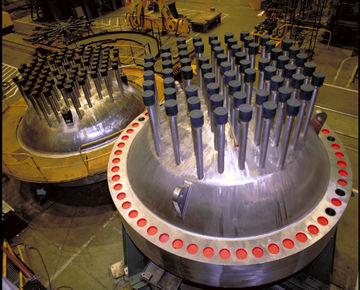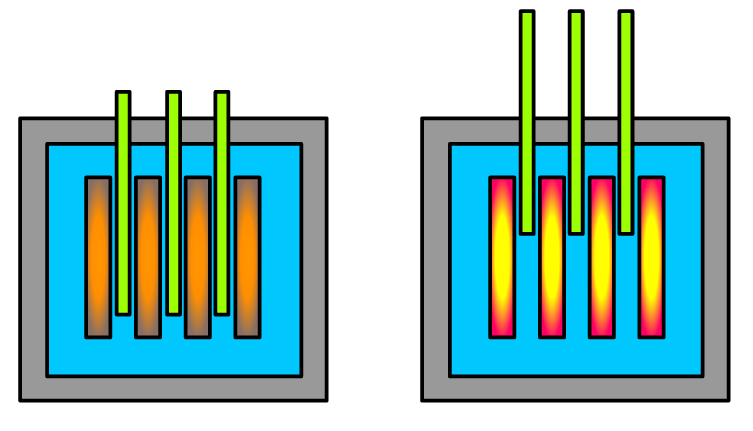Control rod

A control rod is a device that is used to absorb neutrons so that the nuclear chain reaction taking place within the reactor core can be slowed down or stopped completely by inserting the rods further, or accelerated by removing them slightly.[2] Essentially, control rods provide real-time control of the fission process, ensuring that it remains active while preventing it from accelerating out of control.
Uranium-235 fission releases 2.5 neutrons on average, but only one neutron is needed to sustain the nuclear chain reaction at a steady rate. The control rods absorb these extra neutrons and can be used to adjust the power output of the reactor. When inserted the standard amount, their position is at criticality and the power output remains the same.[2] If the rod is pushed in the number of neutrons decreases along with the power output and the reactor is below criticality. The opposite is true if the rods are pulled out slightly as fission goes beyond criticality. This is shown in Figure 2.

Design
Control rods are rods, plates, or tubes containing a material (like boron or hafnium) that absorbs neutrons.[4] Several of these control rods, about the size of fuel rods, are spaced evenly and connected on one end by a metal bracket known as a spider. Typical reactors can contain around 50 of these clusters with 20 individual control rods in each cluster.[5]
The ability of a control rod to absorb neutrons to control the fission chain reaction requires a choice of material that has high neutron-absorbing abilities. The measure of how well a material absorbs neutrons is known as its neutron absorption cross section, or , measured in barns (equal to 10-28 square meters).[5] Generally speaking, control rods are made using cadmium, hafnium, or enriched boron.[2]
Along with the choice in material, the mechanical properties and cost are important when designing a control rod. For example, boron-10 is one of the best neutron absorbers, however it is not ideal for building control rods as it is extremely brittle. Additionally, natural boron must be enriched to have reasonable absorption levels, which becomes very expensive.[5]
Safety Precautions
Control rods are important safety features of reactors as they allow the user to control the output of the reactor. In some types of reactors, most notably CANDU reactors, the control rods are held up by electromagnets. This means that if there is some sort of power failure or loss of signal the control rods are immediately released and fall into the reactor core because of gravity.[6] This prevents the fission reaction from continuing and acts as the primary shutdown system in case of emergency. This dropping motion can also be induced manually if the machinery holding the rods up fails in some way. When the control rods are dropped into the reactor, it is a process known as scramming.[7] In boiling water reactors, the design is different as the control rods must be pushed up into the reactor since they are located on the bottom of the reactor in that design.
References
- ↑ Wikimedia Commons. (July 7, 2015). Reactor Vessel Head [Online]. Available: https://upload.wikimedia.org/wikipedia/commons/f/f8/Reactor_Vessel_head.jpg
- ↑ 2.0 2.1 2.2 Ian Hore-Lacy. (July 7, 2015). Nuclear Energy in the 21st Century, 2nd Ed. Burlington, MA, U.S.A: Elsevier Inc, 2006
- ↑ Wikimedia Commons. (July 7, 2015). Control Rods S chematic [Online]. Available:https://commons.wikimedia.org/wiki/File:Control_rods_schematic.svg#/media/File:Control_rods_schematic.svg
- ↑ NRC Glossary. (July 7, 2015). Control Rods [Online]. Available: http://www.nrc.gov/reading-rm/basic-ref/glossary/control-rod.html
- ↑ 5.0 5.1 5.2 James Grayson. (July 3, 2015). Control Rods in Nuclear Reactors [Online]. Available: http://large.stanford.edu/courses/2011/ph241/grayson1/
- ↑ CANDU 6 Program Team: Reactor Development Business Unit, CANDU 6 Technical Summary, 2005. Available: https://canteach.candu.org/Content%20Library/CANDU6_TechnicalSummary-s.pdf
- ↑ Nuclear Power. (July 7, 2015). Control Rods [Online]. Available: http://www.nuclear-power.net/nuclear-power-plant/control-rods/

